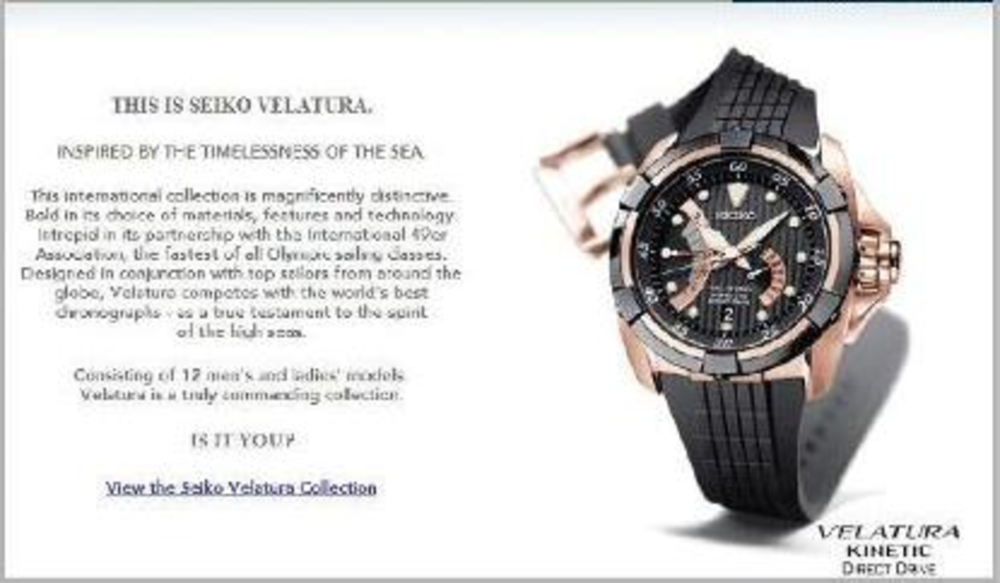Experts say it is e-mail’s time to shine – not just as a lead generator, but as a way to help brands extend their message to a variety of audiences
Two years ago, Seiko did no digital advertising to promote its popular men’s and women’s watches. Today, however, the New Jersey-based brand spends about 20% of its advertising budget on digital channels such as e-mail. As the economy continues to weaken, more and more brands are trying similar tactics — shifting to channels like e-mail, which offer cheap deployment and trackable results. These companies find that with its ability to deliver these results and keep a brand in front of consumers, e-mail is an excellent branding channel, particularly when trying to reach varied audiences.
For Seiko, e-mail helps build its brand in several ways: to communicate with retailers that sell its products; to keep in touch with consumers in its loyalty program called the Elite Group; and to reach members of the press. To help build the brand, e-mail creative is always tied to national ad creative by pulling the basic assets from advertising into the e-mails.
“E-mail re-emphasizes everything that we are trying to do from a brand perspective,” says Les Perry, EVP of sales and marketing for Seiko Corporation of America. “There is a different message based on who it is going to, be it a consumer e-mail or a PR e-mail. But it all ties in with overall advertising campaign.”
Seiko sends tailored messages to each of these three groups every 2.5 weeks and sees an average open rate of 26%, with a 6% to 7% click-through rate.
For its consumer program, Seiko sends weekly e-mails to the 25,000 of its 72,000 Elite Club members who have opted in for updates. Seiko’s marketing e-mails include content about products, special event invitations and featured items. Most of the recipients opt in when a customer registers a watch that he or she has purchased. Seiko is currently redesigning its Web site and will also include a sign-up option for those who want more information.
The e-mail addresses for the participating retailers come from jewelers, who give their contact information when they partner with Seiko. The e-mails include information on popular training programs; give updates for those vendors that have taken the Master Class in Seiko products and feature hot-selling items.
For example, the Ladies’ Diamond watch is one of the best-selling Seiko products at Macy’s, a Seiko retailer. To promote this success, Seiko sent out an e-mail to all of its retailers to let them know about the product. The idea is that if they do not already have it in stock, they may decide to order it. Or, if the retailer has it in stock, it can use this information to give the item more attention when working with customers.
“We are building the relationship with the people who sell the products, so that they have a strong understanding of the brand and how the products work,” Perry explains.
This e-mail was also tailored for press outreach and for consumer-focused communications.
“The ability to talk to [retailers, customers and the press] on a regular basis has become a very efficient operation,” says Debra Purdy, project supervisor at Seiko. “We are reinforcing what we have done in radio, TV and print through these e-mails.”
Seiko is currently working with e-mail service provider Blue Sky Factory to help power these e-mails.
“E-mail is a great branding tool, because it is about being consistent, and being in front of your audience staying in touch and staying in front of the recipient has proven to build brand equity in the mind of the consumer,” says Greg Cangialosi, president and CEO of Blue Sky Factory.
Another well-known brand, Microsoft’s Xbox, is also using e-mail to help build its online gaming subscription’s presence with consumers, boost its relationship management efforts and engage customers.
Through its work with Experian CheetahMail, Microsoft Xbox sends out weekly newsletter e-mails to its Xbox Live subscribers who have opted in, to tell that audience about new products and services.
The content in these weekly updates is dynamically tailored to fit the interests of a customer profile, but the brand message stays consistent.
“It gets them more accustomed to our brands and our products by hearing from us every week,” says Rob Ziemak of Microsoft Xbox. “When it comes to promoting the Xbox brand in e-mail, the idea is to make sure that everything we are doing is all wrapped into the overall brand, so that everything we do is on brand and isn’t diverting for the overall message.”
Xbox also uses e-mail to have a two-way dialog with its customers, which keeps customers participating in the brand. The weekly newsletters include surveys that give customers a chance to comment on which games they like and which games they dislike, says Ziemak.
“It increases our customer intelligence, but it also gives the customer the ability to make their voice heard which helps to build the relationship,” he explains. “They acknowledge that we listen to them, we are a brand and a product that cares about what they think.”
E-mail can achieve this intimacy with customers since it is a one-one-one communication tool.
“It helps to build the brand in that you are communicating with a customer because they’ve told you that they want to hear from you, it’s really about the ability to for brands to connect on this personal level,” explains Kelly Dedman, VP of client services for Experian CheetahMail.
For Seiko, the brand’s goal is to stay true to the national theme, which e-mail takes to a customer’s one-on-one device, whether it is a PC inbox or a mobile phone.
“For everything we do in e-mail, consistency is the underlying word,” says Purdy.







